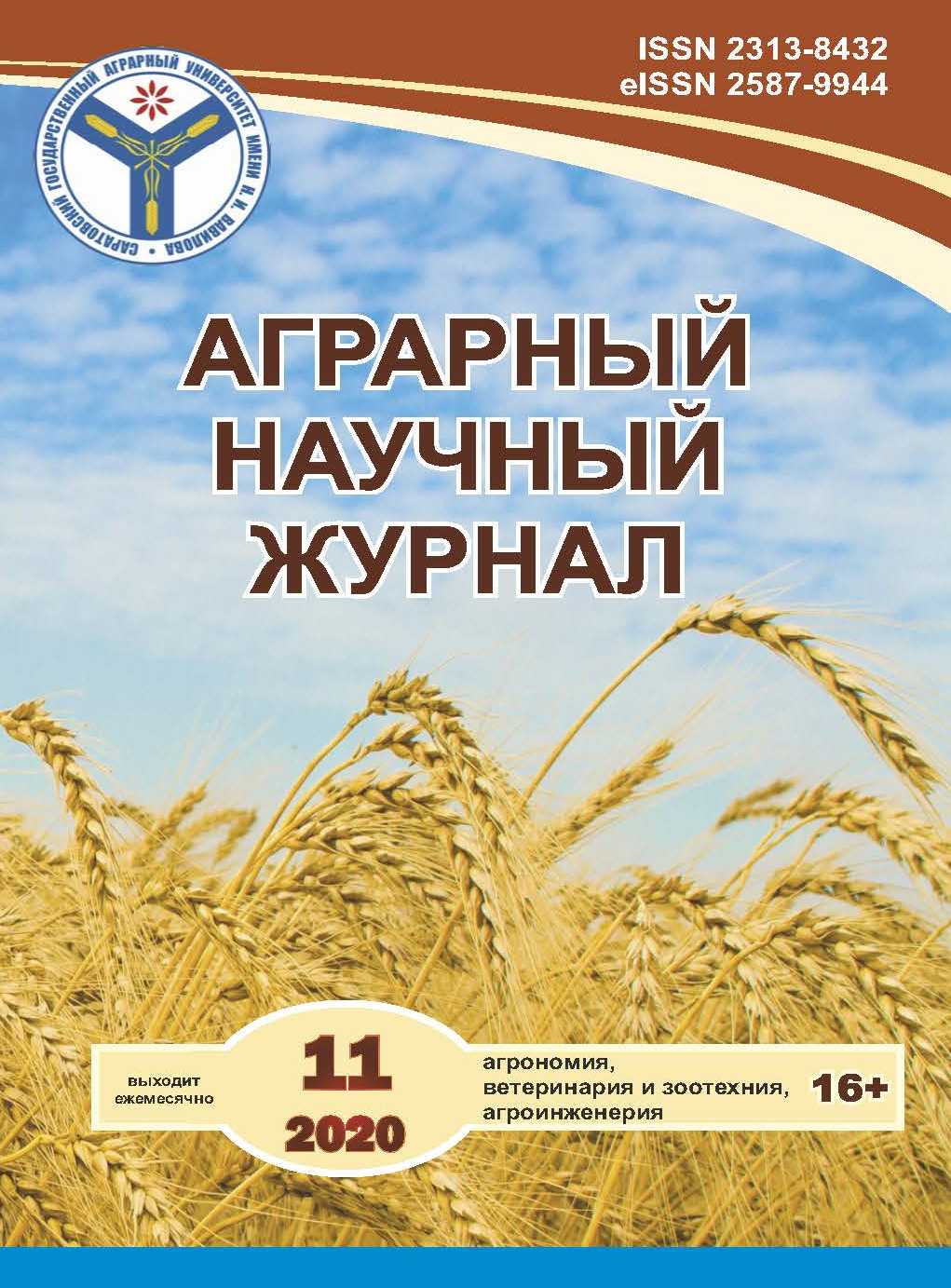Use of cumin and lavender essential oils to control phoma exigua var. foveata on potato during storage
DOI:
https://doi.org/10.28983/asj.y2020i11pp39-42Keywords:
essential oils, cumin, lavender, phoma, potatoAbstract
The antifungal activity of essential oils against Phoma exigua var foveata, was investigated by analyzing its inhibitory effect on the gangrene of potato tubers. The results showed that mycelium growth and spore germination of Phoma was suppressed by treatment with essential oils, and the inhibitory effect strongly correlated with the concentration of essential oils used in this study. The effectiveness of post-harvest treatment with essential oils was studied for induced resistance to Phoma rot in tubers of two potato varieties (Kolobok and Sante). The results showed the fungicidal effect of cumin and lavender essential oils against phomosis at concentrations of 0.1, 0.2, and 0.4, significant inhibition of mycelium growth (18.1-100%), and viability of conidia (12.8-100%) compared to the control. Moreover, both oils at a concentration of 0.4% caused 100% inhibition of mycelium growth and spore germination. Treatment with oils at a concentration of 0.01-0.04 l/t significantly reduced the degree of damage to tubers infected with phomosis. However, cumin essential oil at a concentration of 0.04 l/t had the greatest effect 97.1% compared to lavender oil 95.4%.
Downloads
References
Защита картофеля от болезней, вредителей и сорняков / Б.В. Анисимов [и др.]. – М.: Картофелевод, 2009. – С. 28–31.
Мохаммед С.Р., Еськов И.Д. Использование хитозана против фомоза (гангрены) картофеля при хранении // Аграрный научный журнал. – 2020. – № 1. – С. 17–21.
Попов Ф.А. Изучение фомоза картофеля в условиях Белорусской ССР и меры борьбы с ним : автореф. дис. …канд. с.-х. наук. – Минск, 1978. – 14 с.
Antifungal activity of essential oil from fruits of Indian Cuminum cyminum / C. Romagnoli [et al.] // Pharmaceutical Biology,2010, No. 48(7), Р. 834–838.
Antifungal mechanism of essential oil from Anethum graveolens seeds against Candida albicans / Y. Chen [et al.] // J. Med. Microbiol., 2013, No. 62, P. 1175–1183.
Antigenotoxic effects of three essential oils in diploid yeast (Saccharomyces cerevisiae) after treatments with UVC radiation, 8-MOP plus UVA and MMS / F. Bakkali [et al.] // Mutat. Res., 2006, No. 606 (1-2), P. 27–38.
Antioxidant and antibacterial effects of Lavandula and Mentha essential oils in minced beef inoculated with E. coli O157:H7 and S. aureus during storage at abuse refrigeration temperature / D. Djenane [et al.] // Meat Sci., 2012, No. 92, P. 667–674.
Bang U. Screening of natural plant varieties to control the potato (Solanum tuberosum) pathogens Helminthosporium solani, Fusarium solani, Phoma foveata and Rhizoctonia solani // Potato Res., 2007, No. 50, P. 185–203.
Burt S. Essential oils: their antibacterial properties and potential applications in foods - a review // International Journal of Food Microbiology, 2004, No. 94, P. 223–253.
Chemical Composition and Antifungal Activity of Cuminum cyminum L. Essential Oil from Alborz Mountain Against Aspergillus species / H. Mohammadpour [et al.]. // Jundishapur J Nat Pharm Prod.,2012, No. 7(2), P. 50–55.
Debasish D., Khan А., Dey N. Phoma diseases: Epidemiology and control // Plant Pathology, 2020, P. 1–15.
Essential oils of herbs and spices: Their antimicrobial activity and application in preservation of foods / S.R. Macwan [et al.] // Int. J. Curr. Microbiol. Appl. Sci., 2016, No. 5, P. 885–901.
Essential oils as antimicrobial agents against some important plant pathogenic bacteria and fungi. In Plant-Microbe Interaction: An Approach to Sustainable Agriculture / B.R. Ghalem [et al.], Eds.; Springer Nature Singapore Pte Ltd.: Singapore, 2016, P. 271–296.
Effects of essential oils on phytopathogenic fungi in vitro / A. Zambonelli [et al.] // J. Phytopathol., 2015, No. 144, P. 491–494.
Food and Chemical Toxicology / H. Hajlaoui [ et al.], 2010, 48, P. 2186–2192.
Hyldgaard M., Mygind T., Rikke L.M. Essential oils in food preservation: Mode of action, synergies, and interactions with food matrix components // Front. Microbiol., 2012, No. 3, P. 1–24.
Kalemba D., Kunicka A. Antibacterial and antifungal properties of essential oils // Curr. Med. Chem., 2003, No. 10, P. 813–829.
Kamble V.A. In vitro Anti-Fungal Activity of Cuminum cyminum (Cumin Seed) Essential Oil against Clinical Isolates of Candida Species // AJPCT, 2015, No. 3 (03), P. 264–275.
Lang G., Buchbauer G. A review on recent research results (2008–2010) on essential oils as antimicrobials and antifungals // Flavour Fragr. J., 2012, No. 27, P. 13–39.
Lapwood D.H., Hide G.A. Potato diseases. In "Diseases of Crop Plants" (J. H. Western, ed.), New York.: Wiley, 1971, P. 89–122.
Mechanisms of antifungal and anti-aflatoxigenic properties of essential oil derived from turmeric (Curcuma longa L.) on Aspergillus flavus / Y. Hu [et al.] // Food Chem., 2017, No. 220, P. 1–8.
Population structure and genetic analysis of field resistance to thiabendazole in Gibberella pulicaris from potato tuber / A.E. Desjardins [et al.] // Phytopathology, 1993,Vol. 83, P. 164–170
Scheuerell S., Mahafee W. Compost tea: principles and prospects for plant diseases control // Compost Science and Utilization, 2002, No. 10,– P. 313–338.
Soylu E.M., Kurt S., Soylu S. In vitro and in vivo antifungal activities of the essential oils of various plants against tomato grey mould disease agent Botrytis cinerea // International Journal of Food Microbiology, 2010, No. 143, P. 183–189.
Todd J.M., Adam J.W. Potato gangrene: some interconnected sources and // Proceedings of the 4th British Insecticide and Fungicide Conference, 1967, Р. 276–284.
Downloads
Published
Issue
Section
License
Copyright (c) 2020 The Agrarian Scientific Journal

This work is licensed under a Creative Commons Attribution-NonCommercial 4.0 International License.








